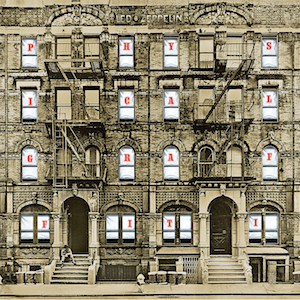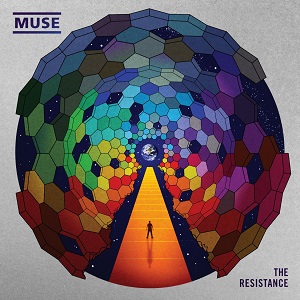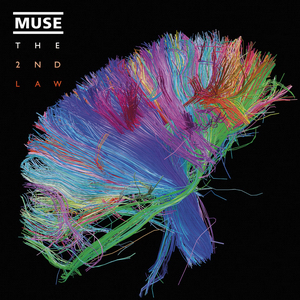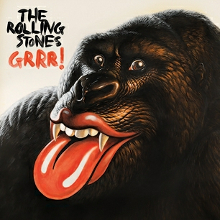
Physical Graffiti is the sixth studio album by the English rock band Led Zeppelin. It was released as a double album on 24 February 1975. It was the group's first album to be released under their new label, Swan Song Records.

Maladroit is the fourth studio album by American rock band Weezer, released on May 14, 2002, by Geffen Records. Produced by the band, it was their first album to feature bassist Scott Shriner, following the departure of former bassist Mikey Welsh in 2001, although he was featured in some music videos for the Green Album songs. Musically, the album features heavy metal riffs uncommon to Weezer's previous releases.

Absolution is the third studio album by the English rock band Muse, released on 15 September 2003 through Taste Media. It was produced by Muse and Rich Costey, with additional production by John Cornfield and Paul Reeve.

Sticky Fingers is the 9th British and 11th American studio album by the English rock band the Rolling Stones. The Stones released it on 23 April 1971 on their new, and own label Rolling Stones Records. They had been contracted by Decca Records and London Records in the UK and the US since 1963. On this album Mick Taylor made his second full-length appearance on a Rolling Stones album. It was the first studio album without Brian Jones who died two years earlier. The original cover artwork, conceived by Andy Warhol and photographed and designed by members of his art collective, The Factory, showed a picture of a man in tight jeans, and had a working zip that opened to reveal underwear fabric. The cover was expensive to produce and damaged the vinyl record, so the size of the zipper adjustment was made by John Kosh at ABKCO records. Later re-issues featured just the outer photograph of the jeans.

Origin of Symmetry is the second studio album by the English rock band Muse, released on 18 June 2001 through Taste Media. It was produced by John Leckie, who produced Muse's debut album, Showbiz (1999), and David Bottrill.

Bursting Out is a 1978 live double album by the rock band Jethro Tull. The album was recorded during the band's European Heavy Horses Tour in May/June of that year.

Voodoo Lounge is the 20th British and 22nd American studio album by the English rock band The Rolling Stones, released on 11 July 1994. As their first new release under their new alliance with Virgin Records, it ended a five-year gap since their last studio album, Steel Wheels in 1989. Voodoo Lounge is also the band's first album without their original bassist Bill Wyman; he left the band in early 1991, though the Stones did not announce the departure until 1993. In 2009, the album was remastered and reissued by Universal Music. This album was released as a double vinyl and as a single CD and cassette.

Unpredictable is the second studio album by American singer-songwriter and actor Jamie Foxx. It was released on December 27, 2005, by J Records. The album was supported by four singles: "Extravaganza" featuring Kanye West, the title track "Unpredictable" featuring Ludacris, "DJ Play a Love Song" featuring Twista, and "Can I Take U Home".

Black Holes and Revelations is the fourth studio album by the English rock band Muse, first released on 3 July 2006 through Warner Bros. Records and Muse's Helium-3 imprint. It was produced by Rich Costey over four months in New York City, London, Milan, and southern France. It saw a change in style for Muse, with influences including Depeche Mode, Millionaire, Lightning Bolt, Sly and the Family Stone, and music from Southern Italy. Like their previous albums, it features political and dystopian undertones, with lyrics covering topics such as political corruption, alien invasion, revolution and New World Order conspiracies, as well as more conventional love songs.

The Outsider is the third studio album by American hip hop producer DJ Shadow, released by Universal Motown Records on September 19, 2006. It peaked at number 77 on the Billboard 200 chart.

The discography of Public Enemy, an American hip hop group, consists of 15 studio albums, two live albums, four compilation albums, two remix albums, one soundtrack album, four video albums, 39 singles, four promotional singles and 39 music videos. The group released their debut studio album, Yo! Bum Rush the Show, in February 1987; it peaked at number 125 on the United States Billboard 200. The album spawned the singles "Public Enemy No. 1" and "You're Gonna Get Yours". Public Enemy released their second studio album, It Takes a Nation of Millions to Hold Us Back, in April 1988. The album peaked at number 42 on the Billboard 200. It has since sold 1.3 million copies in the US, earning a platinum certification from the Recording Industry Association of America (RIAA). Four of the album's singles charted on the US Billboard Hot R&B/Hip-Hop Songs chart: "Bring the Noise", "Don't Believe the Hype", "Night of the Living Baseheads" and "Black Steel in the Hour of Chaos". The former three, along with the single "Rebel Without a Pause", also charted in the United Kingdom.

A Little Bit Longer is the third studio album by the American band the Jonas Brothers and their second album released on Hollywood Records. It was released on August 12, 2008. The album received generally favorable reviews, and four star reviews from Rolling Stone, AllMusic, and Blender. The album was preceded by three singles, "Burnin' Up", "Lovebug" and "Tonight". The album was number 40 on Rolling Stone's Best 50 Albums of 2008. One of the songs from the album, "Video Girl" was also number 49 on Rolling Stone's list of the 100 Best Songs of 2008.

Together Through Life is the 33rd studio album by singer-songwriter Bob Dylan, released on April 28, 2009, by Columbia Records. The release of the album, which reached number 1 in multiple countries, was unexpected and surprised fans. Dylan co-wrote most of the songs with Robert Hunter and recorded with musicians including Mike Campbell of Tom Petty and the Heartbreakers, and David Hidalgo of Los Lobos. The album was recorded at Jackson Browne's Groove Masters studio in Santa Monica, California and produced by Dylan under the pseudonym Jack Frost.

The Resistance is the fifth studio album by English rock band Muse, first released on 11 September 2009 through Warner Bros. Records and Muse's Helium-3 imprint. Produced by the band and mixed by Mark Stent, the album was recorded from September 2008 to May 2009 at Studio Bellini in Lake Como, Italy. Musically, the record is similar to some of the band's previous material, mixing orchestral elements with rock and electronic music. The album also saw the band craft a three-part, 13-minute long symphony piece titled "Exogenesis". Lyrically, it is a concept record, as well as a continuation of the themes from their previous records, being influenced by politics and more oppressive subjects.

The 2nd Law is the sixth studio album by English rock band Muse, first released on 28 September 2012 through Warner Bros. Records and the band's own Helium-3 imprint. Recording of the album took place in studios between London and Los Angeles County, beginning in October 2011 and ending in August 2012. The 2nd Law was Muse's second album to be solely self-produced, following The Resistance (2009), and features a plethora of additional musicians that performed brass, strings, and choir vocals.

GRRR! is a greatest hits album by the Rolling Stones. Released on 12 November 2012, it commemorates the band's 50th anniversary. The album features two new songs titled "Doom and Gloom" and "One More Shot", which were recorded in August 2012.

Live at Rome Olympic Stadium is a live album and video by English rock band Muse, which was released on 29 November 2013 in CD/DVD formats. On 5 November 2013, the film received theatrical screenings in 20 cities worldwide, and the next day it was screened for one night only in 40 other territories. The album contains the band's performance in Italy at Rome's Stadio Olimpico on 6 July 2013, in front of a crowd of 60,963 people. The concert was a part of The Unsustainable Tour, which is a moniker for the band's summer 2013 European leg of The 2nd Law World Tour.

Drones is the seventh studio album by English rock band Muse, released on 5 June 2015 through Warner Bros. Records and the band's own Helium-3 imprint. The album was recorded between October 2014 and April 2015 at the Warehouse Studio in Vancouver, with orchestral sections recorded at Officine Meccaniche in Milan, and was produced by the band and Robert John "Mutt" Lange. Drones is a concept album following a soldier's abandonment, indoctrination as a "human drone", and eventual defection. It also comments on the Obama administration's drone program. After their previous albums incorporated orchestral and electronic music, Muse aimed to return to a more straightforward rock sound musically.

"Give It Up" is a song by American hip hop group Public Enemy, released in July 1994 as the first single from their fifth album, Muse Sick-n-Hour Mess Age (1994). It was their highest-peaking song on the US Billboard Hot 100, reaching number 33.

This Unruly Mess I've Made is the second studio album by American hip hop duo Macklemore & Ryan Lewis. It was released on February 26, 2016, by Macklemore LLC and Alternative Distribution Alliance. Following the success of the duo's hit album The Heist (2012), which earned them their first Grammy wins, the duo delved into lyrical themes that tackle political and social issues, including white privilege, fame and the scrutiny of the media and tabloids. The album was supported by two singles: "Downtown" and "Dance Off", along with "White Privilege II" featuring Jamila Woods, which was released as the album's promotional single.



















